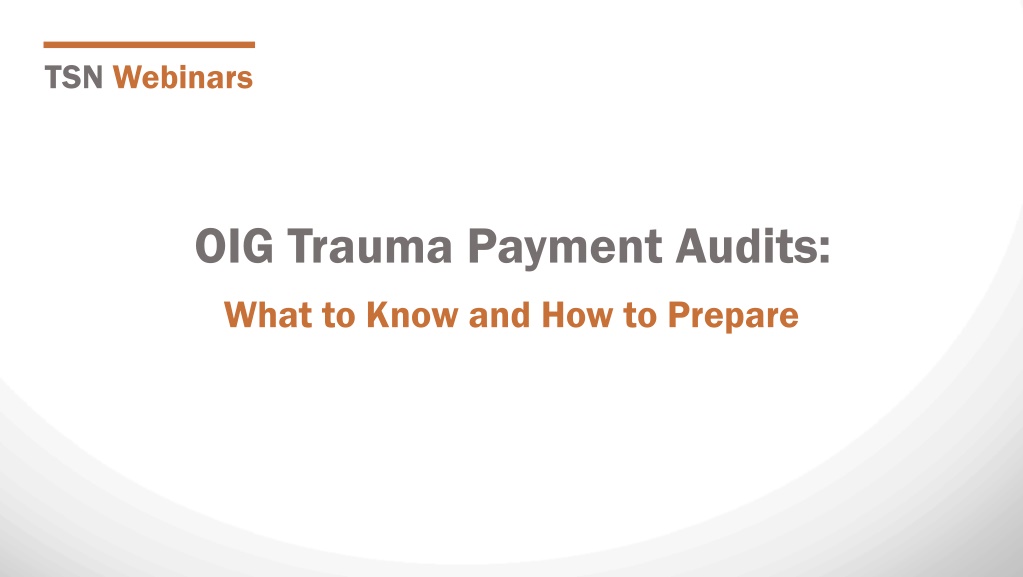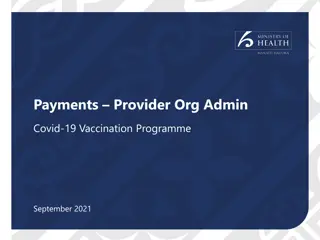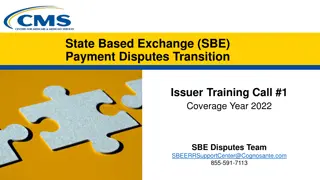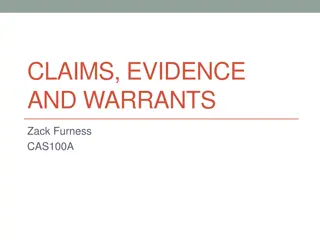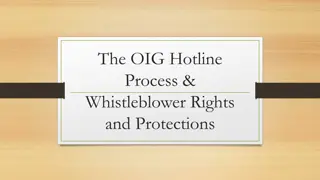Understanding OIG Audits for Trauma Payment Claims
Delve into the intricacies of OIG reviews of trauma payment claims, focusing on the potential impact on Medicare payments for trauma centers and providers. Learn about key issues investigated by the OIG, such as non-designated/verified trauma centers, using revenue codes, trauma team upgrades/downgrades, and proper billing practices. Gain insights into the history of trauma center billing and how to prepare for OIG audits regarding trauma claims.
Download Presentation

Please find below an Image/Link to download the presentation.
The content on the website is provided AS IS for your information and personal use only. It may not be sold, licensed, or shared on other websites without obtaining consent from the author. Download presentation by click this link. If you encounter any issues during the download, it is possible that the publisher has removed the file from their server.
E N D
Presentation Transcript
TSN Webinars OIG Trauma Payment Audits: What to Know and How to Prepare
TSN Webinars Webinar slides and replay Links will arrive by email tomorrow
TSN Webinars Angie Chisolm President & Managing Partner Optimal Healthcare Advisors
What is the OIG? Established in 1976 1,570 auditors, investigators and evaluators Experts in law, technology, cybersecurity, data analytics, statistics, medicine, economics, health policy, and management and administration Focus is fighting waste, fraud and abuse Majority of resources go towards the oversight of Medicare and Medicaid
OIG Review of Medicare Payments for Trauma Claims There have been concerns about trauma centers improperly billing for trauma team activation that is not medically necessary. In addition, we found some providers have received trauma team activation payments without proper designation or verification. Currently, CMS does not track which providers are designated or verified as trauma centers. We will determine the amount of Medicare overpayments and Medicare charges that affect future hospital payments, and we will identify providers that are not trauma centers or that billed for medically unnecessary trauma team activations. Source: Review of Medicare Payments for Trauma Claims The expected date of the OIG report is 2024
4 key issues for OIG investigation Non designated/verified trauma centers using UB 68x revenue code Trauma team upgrades and downgrades How the OIG audit could affect trauma center payments Using UB 68x correctly
History of trauma center billing In 2002, TCAA (Trauma Center Association of America) successfully lobbied the National Uniform Billing Committee (NUBC) to approve trauma response fees and critical care revenue code Only verified or designated trauma centers can use these revenue codes Effective coding, billing and collection practices add revenue for the trauma center; however, trauma centers should base their activation fees on the costs associated with maintaining the trauma center status
Trauma center revenue and billing codes FL 14, Type 5 admit type or source UB 68x trauma team activation fee UB 450 Emergency Room general fee classification UB 208 trauma critical care daily accommodation fee
Designated or verified trauma centers Revenue Code UB 68x Trauma Team Response x indicates trauma center level, not the activation level 681 = Level I 682 = Level II 683 = Level III 684 = Level IV 689 = Other To be used by trauma center/hospitals as licensed government authority authorized to do so, or as verified Surgeons and involving a trauma activation. (Source: CMS Manual System Pub. 100-04) licensed or designated verified by the American College of designated by the State or local
FL 14, Type 5 Trauma Patient Registration Form/Field Locator 14, Type 5 = Trauma Center Used in the registration process to identify the type of patient admission: 1 Emergency 2 Urgent 3 Elective 4 Newborn 5 Trauma Must be used to identify trauma patients for subsequent coding of UB 68x
Trauma Team Upgrades & Downgrades
Upgrades and downgrades Trauma team activations are intended to be medically necessary to meet the needs of the injured patient who would otherwise have a life- or limb-threatening result if left untreated. Downgrade after the trauma team is activated (notified), the patient does not meet the criteria for the level of response. o Examples: o EMS notifies ED of patient with GSW to head. Patient arrives, sitting up on the stretcher with a graze wound to the scalp appropriate downgrade o EMS notifies ED of patient with MVC, rollover, entrapment. After full work up, found to have no injuries and downgraded inappropriate downgrade Upgrade after the trauma team is activated (notified), the patient s condition warrants the need for additional resources. Criteria must be met for the higher level of response. o Examples: o EMS notifies ED of elderly patient fall from standing with leg shortening. After arrival, identified altered mental status from baseline and fractured forearm, in addition to hip fracture appropriate upgrade o EMS notifies ED of patient found down . After arrival, patient found to be intoxicated with no injuries but requires admission inappropriate upgrade
Downgrades Benefit: Patient is not billed for trauma team response Lowers over-triage rates Risk: Overburdening the trauma team with unnecessary notifications OIG is evaluating the practice of charging patients for trauma team activations in the setting of downgrades Having effective, regularly reviewed trauma triage criteria can mitigate the risk of over-triage and the need for downgrading
Upgrades Benefit: Patients receive the level of care necessary to treat the injury Lowers under-triage rates Risk: Delaying care for patients in need of rapid evaluation Activating a team response when a simple surgical consult is needed OIG is evaluating the practice of upgrading patients to trauma team activations after workup is complete, which is essentially a surgical consult Having effective, regularly reviewed trauma triage criteria can mitigate the risk of under-triage and the need for upgrading
Supporting documentation Requirements: Requirements: Trauma Team Activation criteria Trauma Team Activation roles and responsibilities (including expected response times)
Ways to manage the problem Evaluate over- and under-triage regularly Adjust your activation criteria to reduce upgrades/downgrades Always provide the appropriate level of care to the patient and support clinical decisions with documentation When auditing, ask: Did the patient meet criteria for activation on arrival? Did the patient s condition change after arrival? Was the decision to upgrade/downgrade clearly documented?
TSN Webinars Break Would you like personal follow-up?
How will this affect trauma center payments?
How the OIG audit could affect trauma center payments We will determine the amount of Medicare overpayments and Medicare charges that affect future hospital payments, and we will identify providers that are not trauma centers or that billed for medically unnecessary trauma team activations. It is unclear at this time what action may be taken by CMS once the OIG report is available, but it could include fines and/or future payment adjustments
CMS rules for billing UB 68x Must be identified using FL 14, Type 5 Must use UB 68x revenue code Must use G0390 combined with 30 minutes of critical care time (99291)* Must meet trauma team activation criteria Each Each level of response must be clearly defined, including team members Must show evidence of prehospital notification * NOTE: Critical care time is not required to bill UB 68x. CMS states that when there is 30 mins of critical care, you must include G0390
UB 68x and prenotification CMS: Qualifying prehospital caregivers: EMS Police Fire Referring facility (ED, urgent care, doctor s office, SNF, rehab, etc.) Source: Uniform Billing Editor
UB 68x without prenotification Cannot bill using revenue code UB 68x without pre-notification The National Uniform Billing Committee specifically instructs a hospital to bill UB450 in addition to UB68X when pre-arrival notification is given. The UB 450 level of service is the only alternative to recover costs when a patient arrives without pre-notification. Every patient must still meet the trauma team activation criteria. (TCAA Finance and Business Manual) Charges should be related consistently to the cost of the services and uniformly applied to all patients whether inpatient or outpatient. (Provider Reimbursement Manual 1, Chapter 22, Section 2202.4)
Conclusion Evaluate your trauma program s use of upgrades and downgrades Regularly evaluate your trauma team activation criteria Ensure clinical documentation supports the use of revenue code UB 68x for trauma team activation, including critical care time Review your center s chargemaster to ensure the correct UB 68x code for your trauma center level and you are only using 450 if not designated/verified If you are unsure, reach out to a trauma finance coding specialist for assistance
TSN Webinars Your Questions Click the Q&A icon
TSN Webinars Thank You Watch email tomorrow Take exit survey
